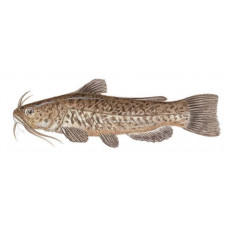Latin name
Ameiurus nebulosus
Other names
Bullpout, horned pout, brown catfish, mudcat, common bullhead, marbled bullhead, squaretail, minister; French: barbotte brune.
Identification
The head of the brown bullhead is large for its round and slender body, and the skin is smooth and completely out of scales. The coloration is not always brown; it can range from yellowish brown or chocolate brown to gray or olive with brown or black scattered spots. The belly is yellow or white. Brown bullhead differs from yellow bullhead in mottled coloration and dark brown or nearly black underbelly spines. The pectoral process of the pectoral fin has sharp, tooth-like serrations, and the tail is flattened or slightly serrated.
Distribution
Brown bullhead is found from Nova Scotia and New Brunswick to Saskatchewan, from North Dakota to Louisiana in the west, and from Maine to Florida in the east. Native to the eastern United States and southern Canada, but they have been introduced to other countries.
Habitat
Brown bullhead inhabits warm and even stagnant waters, as well as sluggish streams with a muddy bottom. They are found in farm ponds, pools, streams, small and large rivers, lakes, and reservoirs. In contrast to others bullhead, they are found in large and deep waters, although they are, able to withstand low oxygen concentrations and, as is known, are buried in silt to survive in such conditions.
Size
The average weight of the brown bullhead is less than a pound, and although fish weighing from 2 to 4 pounds are sometimes caught, the weight of this species rarely exceeds 3 pounds. The fish weighing 6 pounds and 5 ounces is the largest ever caught on a fishing rod and reel. Brown bullhead can grow up to 21 inches in length, although most often they are 8 to 14 inches long. Their life expectancy is 6 or 7 years.
Life history and Behavior
Spawning occurs in April-May.
Food and feeding habits
The brown bullhead feeds mainly at night on immature insects, worms, minnows, mollusks, crayfish, plankton and offal.
Reproduction
Nests are made by one or both sexes. Eggs are guarded by one or both parents, some fish eat them. Young individuals are pitch black and resemble tadpoles, forming large flocks that swim in surface waters. The male continues to guard the cubs until they reach 2 inches in length and cannot protect themselves.
| Classification | |
| Phylum | Chordata |
| Class | Actinopterygii |
| Squad | Siluriformes |
| Family | Ictaluridae |
| Genus | Ameiurus |
| Species | A. nebulosus |
| Features | |
| Conservation status | Least Concern |
| Habitat | Bottom |
| Life span, years | 7 |
| Maximum body weight, kg | 3.6 |
| Maximum length, cm | 50 |
| Sailing speed, m/s | No information |
| Threat to people | Edible |
| Way of eating | Predator |



